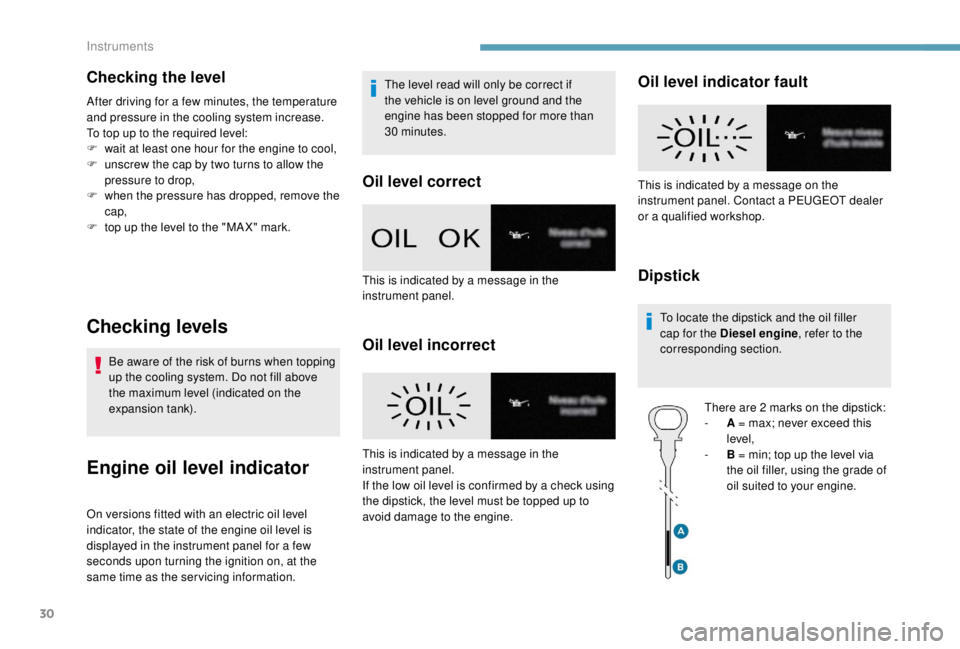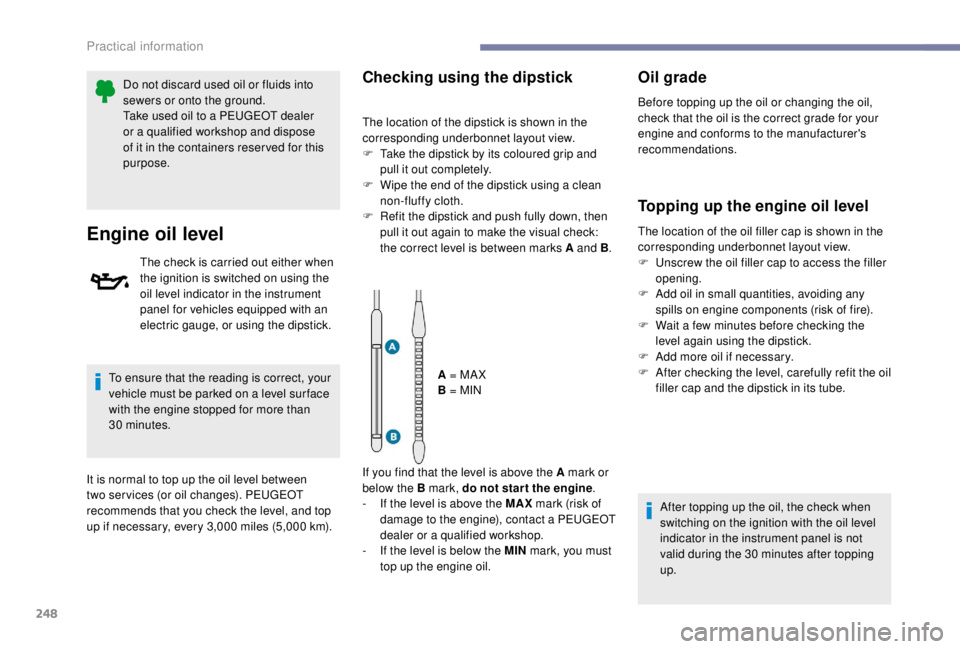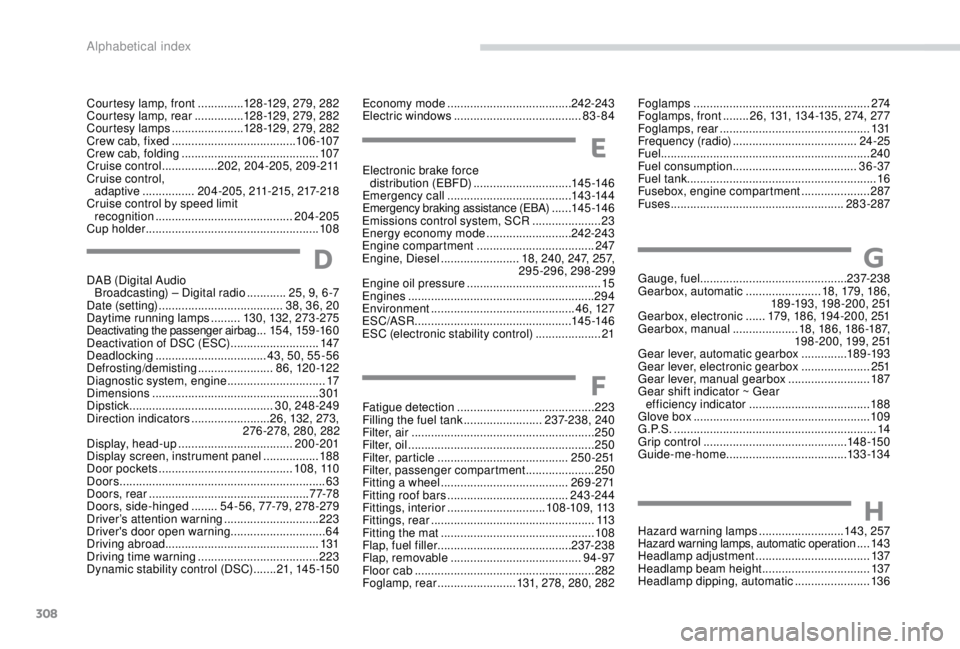2018 PEUGEOT EXPERT oil dipstick
[x] Cancel search: oil dipstickPage 32 of 416

30
Checking the level
After driving for a few minutes, the temperature
and pressure in the cooling system increase.
To top up to the required level:
F
w
ait at least one hour for the engine to cool,
F
u
nscrew the cap by two turns to allow the
pressure to drop,
F
w
hen the pressure has dropped, remove the
cap,
F
t
op up the level to the "MA X" mark.
Checking levels
Be aware of the risk of burns when topping
up the cooling system. Do not fill above
the maximum level (indicated on the
expansion tank).
Engine oil level indicator
On versions fitted with an electric oil level
indicator, the state of the engine oil level is
displayed in the instrument panel for a few
seconds upon turning the ignition on, at the
same time as the ser vicing information. The level read will only be correct if
the vehicle is on level ground and the
engine has been stopped for more than
30
minutes.
Oil level correct
Oil level incorrect
Oil level indicator fault
Dipstick
To locate the dipstick and the oil filler
cap for the Diesel engine
, refer to the
corresponding section.
There are 2
marks on the dipstick:
-
A
= max; never exceed this
level,
-
B
= min; top up the level via
the oil filler, using the grade of
oil suited to your engine.
This is indicated by a message in the
instrument panel.
This is indicated by a message in the
instrument panel.
If the low oil level is confirmed by a check using
the dipstick, the level must be topped up to
avoid damage to the engine. This is indicated by a message on the
instrument panel. Contact a PEUGEOT dealer
or a qualified workshop.
Instruments
Page 249 of 416

247
Engine
Diesel
The Diesel fuel system operates under
high pressure:
-
N
ever carry out any work on the
system yourself.
-
H
Di engines make use of advanced
technology.
Specialist knowledge is needed for any
work on the system, which can only be
assured by PEUGEOT dealers.
This engine is an example only. The location of the dipstick and engine oil filler cap, as well as the
priming pump may vary.
1.
Screenwash and headlamp wash
reservoir.
2. Engine coolant reservoir.
3. Engine oil filler cap.
4. Engine oil dipstick.
5. Priming pump.
6. Brake fluid filler cap.
7. Battery.
8. Remote earth point ("-" terminal).
9. Fusebox. 10.
Power steering fluid reservoir.
11. A i r f i l t e r.
Checking levels
Check all of these levels regularly, in line with
the manufacturer's service schedule. Top them
up if necessary, unless other wise indicated.
If a level drops significantly, have the
corresponding system checked by a PEUGEOT
dealer or a qualified workshop.
The fluid must comply with the
manufacturer's recommendations and with
the vehicle's engine.
Take care when working under the bonnet,
as certain areas of the engine may be
extremely hot (risk of burns) and the
cooling fan could start at any time (even
with the ignition off).
Used products
Avoid prolonged contact of used oil or
fluids with the skin.
Most of these fluids are harmful to health
or indeed very corrosive.
7
Practical information
Page 250 of 416

248
Do not discard used oil or fluids into
sewers or onto the ground.
Take used oil to a PEUGEOT dealer
or a qualified workshop and dispose
of it in the containers reser ved for this
purpose.
Engine oil level
The check is carried out either when
the ignition is switched on using the
oil level indicator in the instrument
panel for vehicles equipped with an
electric gauge, or using the dipstick.
To ensure that the reading is correct, your
vehicle must be parked on a level sur face
with the engine stopped for more than
30
minutes.
It is normal to top up the oil level between
two ser vices (or oil changes). PEUGEOT
recommends that you check the level, and top
up if necessary, every 3,000
miles (5,000 km).
Checking using the dipstick
The location of the dipstick is shown in the
corresponding underbonnet layout view.
F
T
ake the dipstick by its coloured grip and
pull it out completely.
F
W
ipe the end of the dipstick using a clean
non-fluffy cloth.
F
R
efit the dipstick and push fully down, then
pull it out again to make the visual check:
the correct level is between marks A and B .
A = MA X
B = MIN
If you find that the level is above the A mark or
below the B mark, do not star t the engine .
-
I
f the level is above the MAX mark (risk of
damage to the engine), contact a PEUGEOT
dealer or a qualified workshop.
-
I
f the level is below the MIN mark, you must
top up the engine oil.
Oil grade
Before topping up the oil or changing the oil,
check that the oil is the correct grade for your
engine and conforms to the manufacturer's
recommendations.
Topping up the engine oil level
The location of the oil filler cap is shown in the
corresponding underbonnet layout view.
F
U
nscrew the oil filler cap to access the filler
opening.
F
A
dd oil in small quantities, avoiding any
spills on engine components (risk of fire).
F
W
ait a few minutes before checking the
level again using the dipstick.
F
A
dd more oil if necessary.
F
A
fter checking the level, carefully refit the oil
filler cap and the dipstick in its tube.
After topping up the oil, the check when
switching on the ignition with the oil level
indicator in the instrument panel is not
valid during the 30
minutes after topping
up.
Practical information
Page 406 of 416

308
G
H
Gauge, fuel............................................. 237-238
Gearbox, automatic .......................18, 179, 186,
189 -193, 198 -20 0, 251
Gearbox, electronic
......179, 186, 194-200, 251
Gearbox, manual
....................18, 18 6, 18 6 -187,
198 -20 0, 19 9, 251
Gear lever, automatic gearbox
..............18 9 -19 3
Gear lever, electronic gearbox
.....................2 51
Gear lever, manual gearbox
.........................187
Gear shift indicator ~ Gear efficiency indicator
..................................... 188
Glove box
...................................................... 109
G . P. S .
.............................................................. 14
Grip control
............................................ 14 8 -15 0
Guide-me-home
..................................... 13 3 -13 4
Hazard warning lamps
..........................143, 257
Hazard warning lamps, automatic operation
....143
Headlamp adjustment
...................................137
Headlamp beam height
................................. 13
7
Headlamp dipping, automatic
.......................13 6
Electronic brake force
distribution (EBFD)
.............................. 14
5 -14 6
Emergency call
......................................
143 -14 4
Emergency braking assistance (EBA)
...... 14
5 -14 6
Emissions control system, SCR
.....................
23
Energy economy mode
.......................... 24
2-243
Engine compartment
.................................... 2
47
Engine, Diesel
........................
18, 240, 247, 257,
295-296, 298-299
Engine oil pressure
......................................... 15
Engines
......................................................... 294
Environment
............................................ 4 6, 127
ESC/ASR
................................................145 -14 6
ESC (electronic stability control)
.................... 21
E
F
Fatigue detection .......................................... 223
Filling the fuel tank ........................237-238, 240
Filter, air
........................................................ 250
Filter, oil
................
......................................... 250
Filter, particle
........................................ 250-251
Filter, passenger compartment
.....................250
Fitting a wheel
....................................... 2 6 9 -271
Fitting roof bars
..................................... 243 -244
Fittings, interior
.............................. 10
8 -109, 113
Fittings, rear
.................................................. 113
Fitting the mat
............................................... 108
Flap, fuel filler
......................................... 237-238
Flap, removable
..............................
..........94-97
Floor cab
....................................................... 282
Foglamp, rear
........................ 131, 278, 280, 282
DDAB (Digital Audio
Broadcasting) – Digital radio ............25, 9, 6 -7
Date (setting)
...................................... 38, 36, 20
Daytime running lamps
.........13 0, 132, 273 -275
Deactivating the passenger airbag ...154, 159 -16 0
Deactivation of DSC (ESC)
........................... 147
Deadlocking
.................................. 43, 50, 55 -56
Defrosting/demisting
....................... 8 6, 120 -12 2
Diagnostic system, engine
.............................. 17
D
imensions
..............................
..................... 301
Dipstick
................
............................ 30, 248-249
Direction indicators
........................ 26, 132, 273,
276 -278, 280, 282
Display, head-up
...............................
....200-201
Display screen, instrument panel
................. 188
Door pockets
...............................
.......... 108, 110
Doors
............................................................... 63
Doors, rear
................................................. 7 7-78
Doors, side-hinged
........ 5
4-56, 77-79, 278-279
Driver’s attention warning
............................. 223
Driver's door open warning
............................. 64
Driving abroad ............................................... 131
Driving time warning
..................................... 223
Dynamic stability control (DSC)
....... 21, 14 5 -15 0
Courtesy lamp, front
..............
128 -12 9, 279, 282
Courtesy lamp, rear
...............
128 -12 9, 279, 282
Courtesy lamps
......................
128 -12 9, 279, 282
Crew cab, fixed
......................................
10 6 -107
Crew cab, folding
..........................................
107
Cruise control
.................
202, 204-205, 209-211
Cruise control, adaptive
................
204 -205, 211-215, 217-218
Cruise control by speed limit recognition
...............................
...........
204-205
Cup holder
.....................................................
108Economy mode
......................................
24
2-243
Electric windows
.......................................
83-84Foglamps
......................................................
2 74
Foglamps, front
........
26, 131, 134-135, 274, 277
Foglamps, rear
.............................................. 13
1
Frequency (radio)
......................................
24-25
Fuel ................................................................ 240
Fuel consumption
......................................
36 -37
Fuel tank .......................................................... 16
Fusebox, engine compartment
.....................
287
Fuses
..................................................... 28
3-287
Alphabetical index